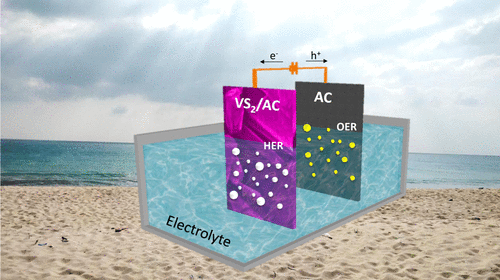当前位置:
X-MOL 学术
›
ACS Sustain. Chem. Eng.
›
论文详情
Our official English website, www.x-mol.net, welcomes your feedback! (Note: you will need to create a separate account there.)
Sustained Solar-Powered Electrocatalytic H2 Production by Seawater Splitting Using Two-Dimensional Vanadium Disulfide
ACS Sustainable Chemistry & Engineering ( IF 8.4 ) Pub Date : 2021-06-15 , DOI: 10.1021/acssuschemeng.1c01909 Paulraj Gnanasekar 1, 2 , Mathan Kumar Eswaran 3 , Gayathri Palanichamy 1 , Tien Khee Ng 2 , Udo Schwingenschlögl 3 , Boon S. Ooi 2 , Jeganathan Kulandaivel 1
ACS Sustainable Chemistry & Engineering ( IF 8.4 ) Pub Date : 2021-06-15 , DOI: 10.1021/acssuschemeng.1c01909 Paulraj Gnanasekar 1, 2 , Mathan Kumar Eswaran 3 , Gayathri Palanichamy 1 , Tien Khee Ng 2 , Udo Schwingenschlögl 3 , Boon S. Ooi 2 , Jeganathan Kulandaivel 1
Affiliation

|
Robust and stable electrodes made from earth-abundant materials have gained widespread interest in large-scale electrocatalytic water splitting toward hydrogen energy technologies. In this study, the vanadium disulfide (VS2)/amorphous carbon (AC) heterostructure was employed as an electrode for direct seawater splitting. Two-dimensional VS2 nanoparticles were deposited on AC with a high degree of uniformity via a well-optimized one-step chemical vapor deposition approach. The VS2/AC heterostructure electrode was found to possess rich active sulfur sites, near-zero Gibbs free energy, a large surface area, and exceptional charge transfer toward the electrolyte, resulting in enhanced hydrogen evolution reaction (HER) performance with a low onset potential and low overpotential of 11 and 61 mV (vs reversible hydrogen electrode (RHE)), respectively. The electrode also sustained robust stability throughout the 50 h of chronoamperometry studies under acidic electrolyte conditions. Interestingly, the VS2/AC electrocatalyst accomplished an exceptional HER performance under natural seawater conditions in the absence of an external electrolyte with an onset potential of 56 mV vs RHE and attained η200 at an overpotential of 0.53 V vs RHE. In spite of this, the heterostructure exhibited superior stability over 21 days at a high current density of 250 mA/cm2 under both indoor and solar-powered outdoor conditions. Overall, this VS2/AC heterostructure may open a new pathway toward direct seawater splitting for long-term, stable, large-scale hydrogen generation.
中文翻译:

使用二维二硫化钒通过海水分裂持续太阳能电催化生产H 2
由地球上丰富的材料制成的坚固而稳定的电极在大规模电催化水分解为氢能技术方面引起了广泛的兴趣。在这项研究中,二硫化钒(VS 2)/无定形碳(AC)异质结构被用作直接分解海水的电极。二维 VS 2纳米粒子通过优化的一步化学气相沉积方法以高度均匀的方式沉积在 AC 上。VS 2发现 /AC 异质结构电极具有丰富的活性硫位点、接近零的吉布斯自由能、大的表面积和向电解质的特殊电荷转移,导致析氢反应 (HER) 性能增强,起始电位低,低过电位分别为 11 和 61 mV(相对于可逆氢电极 (RHE))。在酸性电解质条件下,电极在 50 小时的计时电流法研究中也保持了强大的稳定性。有趣的是,在没有外部电解质的情况下,VS 2 /AC 电催化剂在天然海水条件下实现了卓越的 HER 性能,起始电位为 56 mV vs RHE 并达到 η 200在 0.53 V 相对于 RHE 的过电位下。尽管如此,在室内和室外太阳能供电条件下,异质结构在 250 mA/cm 2的高电流密度下表现出优异的稳定性超过 21 天。总体而言,这种 VS 2 /AC 异质结构可能为海水直接分解以实现长期、稳定、大规模的制氢开辟了一条新途径。
更新日期:2021-06-28
中文翻译:

使用二维二硫化钒通过海水分裂持续太阳能电催化生产H 2
由地球上丰富的材料制成的坚固而稳定的电极在大规模电催化水分解为氢能技术方面引起了广泛的兴趣。在这项研究中,二硫化钒(VS 2)/无定形碳(AC)异质结构被用作直接分解海水的电极。二维 VS 2纳米粒子通过优化的一步化学气相沉积方法以高度均匀的方式沉积在 AC 上。VS 2发现 /AC 异质结构电极具有丰富的活性硫位点、接近零的吉布斯自由能、大的表面积和向电解质的特殊电荷转移,导致析氢反应 (HER) 性能增强,起始电位低,低过电位分别为 11 和 61 mV(相对于可逆氢电极 (RHE))。在酸性电解质条件下,电极在 50 小时的计时电流法研究中也保持了强大的稳定性。有趣的是,在没有外部电解质的情况下,VS 2 /AC 电催化剂在天然海水条件下实现了卓越的 HER 性能,起始电位为 56 mV vs RHE 并达到 η 200在 0.53 V 相对于 RHE 的过电位下。尽管如此,在室内和室外太阳能供电条件下,异质结构在 250 mA/cm 2的高电流密度下表现出优异的稳定性超过 21 天。总体而言,这种 VS 2 /AC 异质结构可能为海水直接分解以实现长期、稳定、大规模的制氢开辟了一条新途径。


























 京公网安备 11010802027423号
京公网安备 11010802027423号